Corbyn and the mural (one last time)
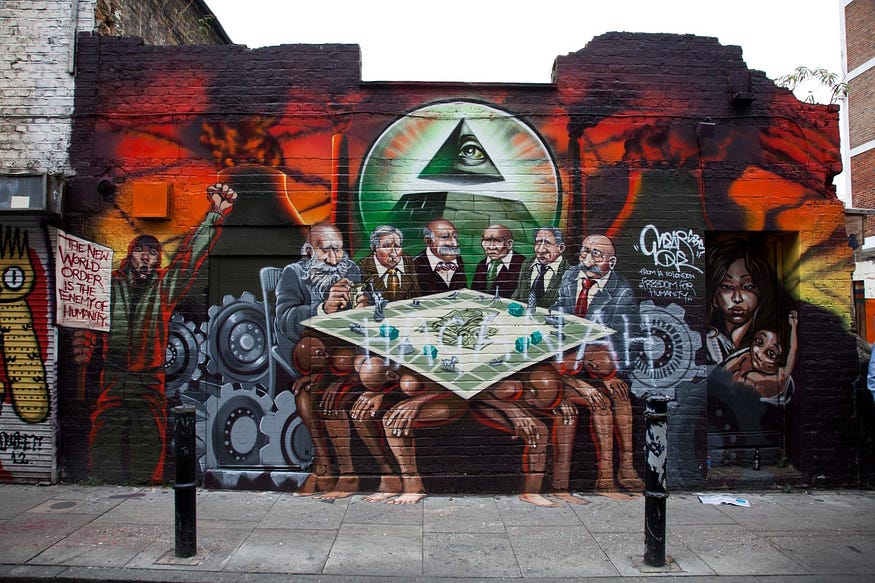
Given that it is over seven years since the controversy over Jeremy Corbyn and that mural kicked off big time, you might have thought it would be forgotten by now, yet the issue still provokes heated debate, not least on social media.
If the mural controversy were restricted to twitter spats, though, it would arguably be a marginal issue. But it continues to impact mainstream politics. Last year Nigel Farage cited the mural in support of his defamatory accusation that Corbyn is “a subscriber to the madcap conspiracy theory that the Jews run the world”. During the general election campaign, in an obvious attempt to undermine Corbyn’s independent candidacy in Islington North, the Zionist-extremist outfit calling itself Campaign Against Antisemitism rebooted the narrative about Labour’s descent into Jew-hatred “under the leadership of the antisemite Jeremy Corbyn”. They obstinately upheld the myth that Corbyn had given his approval to “an antisemitic mural depicting big-nosed Jewish bankers exploiting the masses”. Following his announcement of the intended formation of a new leftwing political party, this line of attack on Corbyn can only persist, particularly if the new party attracts significant electoral support.
That’s my excuse for returning to the subject one more time. (For earlier articles see here and here.) What I want to show is that assertions about the antisemitic character of the mural are mostly incoherent, contradictory and motivated by a need to convict Corbyn of a failure to immediately recognise what his political enemies hold to be an obviously racist artwork, rather than by any objective analysis. I’ll conclude with a summary of my own interpretation of the ideology that inspired the work.
Back in 2012, in response to an indignant Facebook post by the street artist Mear One (real name Kalen Ockerman) complaining that his mural off Brick Lane in Tower Hamlets was about to be wiped out, Corbyn famously asked: “Why? You are in good company. Rockerfeller destroyed Diego Viera’s mural because it includes a picture of Lenin.” (He was referring to Mexican artist Diego Rivera’s 1933 fresco Man at the Crossroads.) At that point there had been no news reports of objections to the mural on the grounds that it was antisemitic, and Mear One’s post made no mention of this. So Corbyn was evidently puzzled by the decision to have it obliterated, and guessed that the cause of the dispute was the anti-capitalist character of the work.
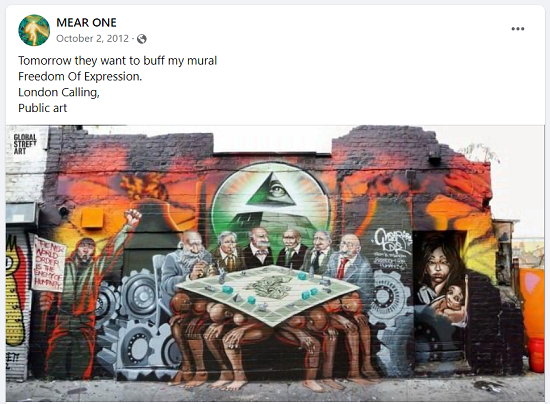
Interviewed by Lewis Goodall in 2023, Corbyn recalled that he had seen Ockerman’s post “very briefly, late at night when I was scrolling through Facebook, and maybe it’s a bad idea to scroll through Facebook late at night. I saw it and on my mind was the way in which Diego Rivera’s murals had been removed in the USA. And I thought, hang on, why are we taking murals down in Tower Hamlets? I didn’t look at it very closely, that I accept. And so I didn’t say I approved it. I just said, why is it being removed? I then got a message the following morning, as to what the objection was, and the then mayor, now mayor, of Tower Hamlets, Lutfur Rahman, asked for its removal. And I said, good, I absolutely support that.”
Even if he had taken a closer look at Ockerman’s Facebook post that night, it is uncertain whether Corbyn would have recognised the mural as antisemitic. In 2012 opinion was divided over this question, reflecting the visually ambiguous character of the work. Some people examined it superficially, saw several men with large noses, one of whom was counting money, concluded that all the figures around the table must be Jews, and declared that antisemitism was straightforwardly observable in the mural’s imagery. (I was one of them. I described it as “a clearly racist mural featuring antisemitic caricatures of scheming Jewish bankers”.) Others subjected the images to closer examination and took a more nuanced view. Among them was, of all people, the Harry’s Place blogger David Toube, aka Lucy Lips, who described his initial response as follows:
“I’ve seen the mural, in person. It is clearly a conspiracist work. In particular, the use of the pyramid motif from the dollar bill is a favourite theme of those who are fixated on freemasons and illuminati. But were the men with beards supposed to be Jews? Well, possibly — but I’ve seen more obvious stereotypes of Jews deployed in antisemitic art. This is what Mick Hartley had to say: ‘Do the members of that evil cabal have big hooked noses, by any chance? Hmm….we’ll give him the benefit of the doubt on that one. Just.’ That was my view too.”
It was only after he had read the artist’s own comments on his work that Toube decided — based on his (flawed) understanding of the ideas behind it, rather than on its visual imagery — that the mural was antisemitic after all. Even so, he opposed the decision to have it painted over, on the grounds that it would be “gone in due course — the wall is a shifting canvas for a range of artists”. Interestingly, Jewish Chronicle editor Stephen Pollard concurred with Toube’s appraisal, tweeting that “Lucy Lips has it exactly right on the antisemitic Tower Hamlets mural”. But that, of course, was before Corbyn became Labour leader and shocked the political establishment with a near-victory in the 2017 general election. When the furore over the mural broke out in 2018, initiating an escalating and increasingly hysterical anti-Corbyn campaign, nuance went out the window and both Toube and Pollard took a very different position.

Following Corbyn’s election to the Labour leadership a number of attempts were made to stir up controversy over his 2012 comment on the mural. Marcus Dysch wrote an article for the Jewish Chronicle in November 2015, which in contrast to the JC’s later coverage of the subject was circumspect in its criticism of Corbyn — it referred to his having “apparently backed” a mural with antisemitic “undertones”. The story failed to gain traction. In 2016 a Sunday Telegraph article co-authored by Andrew Gilligan also criticised Corbyn over his stance on the mural. This took a less cautious position on the character of the artwork, describing it (inaccurately) as featuring “stereotypical Jewish figures counting money”, but it too failed to generate wider media attention.
Another, more obscure, individual pursuing Corbyn over the mural was a genocide-supporting pro-Israel fanatic tweeting as “Clare Quilty”. (The name of a character from Vladimir Nabokov’s novel Lolita with a sexual predilection for under-age girls, apparently. Quite why anyone should choose this as a pseudonym is unclear.) In 2015 Quilty tried to get Douglas Murray and Nick Cohen interested in taking up the mural issue, in an attempt to smear Corbyn as an antisemite. (“Is there a difference in supporting antisemites or being one”, he prompted Cohen.) To no effect. But the 2017 general election, which almost brought to power a leftwing government under a pro-Palestinian prime minister, changed the situation. Corbyn’s political enemies, and the Zionist lobby in particular, were now looking for an opportunity to destroy him. In March 2018 Quilty’s perseverance finally paid off, when he found an audience for this tweet.
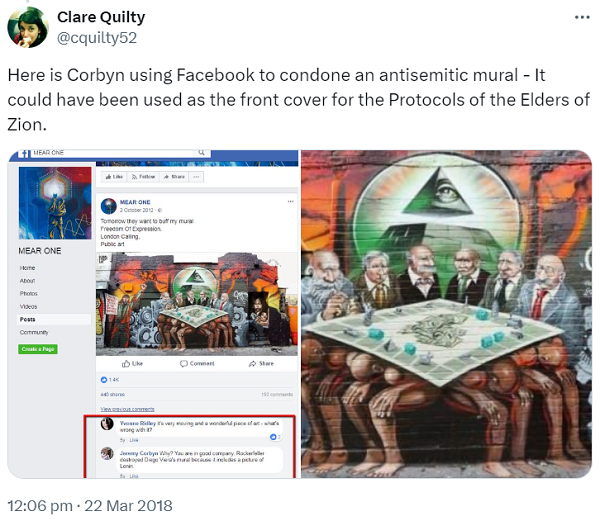
That was what triggered the hysteria over the mural. On the afternoon of 23 March rightwing Labour MP and Corbyn critic Luciana Berger tweeted the same screenshots that Quilty had posted the previous day. Berger announced that she had contacted Corbyn’s office that morning to ask for an explanation of his 2012 reaction to the mural. The fact that she went public with this demand only hours later suggests that she wasn’t so much interested in an explanation of Corbyn’s long-ago Facebook comment as in creating a crisis for the Labour Party, in order to damage a leadership to which she was politically opposed.

Quilty’s assertion that Ockerman’s artwork “could have been used as the front cover for the Protocols of the Elders of Zion” had an obvious purpose — namely, to suggest that the images in the mural were so blatantly and unambiguously racist that Corbyn’s failure to instantly condemn it showed he was soft on antisemitism if not an antisemite himself. It proved to be a popular line of attack. The Protocols comparison was picked up and uncritically repeated by a number of Corbyn’s political opponents, notably by David Baddiel in an article published in the Sunday Times the following week. (The text was later incorporated into Baddiel’s heavily-hyped 2021 book Jews Don’t Count.)
However, as former JPR director Tony Lerman has argued in his book Whatever Happened to Antisemitism? Redefinition and the Myth of the ‘Collective Jew’, the parallel with cover illustrations for The Protocols is pretty much non-existent. He notes that “a quick look at images of such covers on Google reveals nothing resembling the mural. Covers are either text, usually designed to indicate the ‘seriousness’ of the publication, or gross caricatures of Jews barely showing any resemblance to the men sitting around the Monopoly board.” As the illustrations below confirm, Lerman is undoubtedly correct about this.
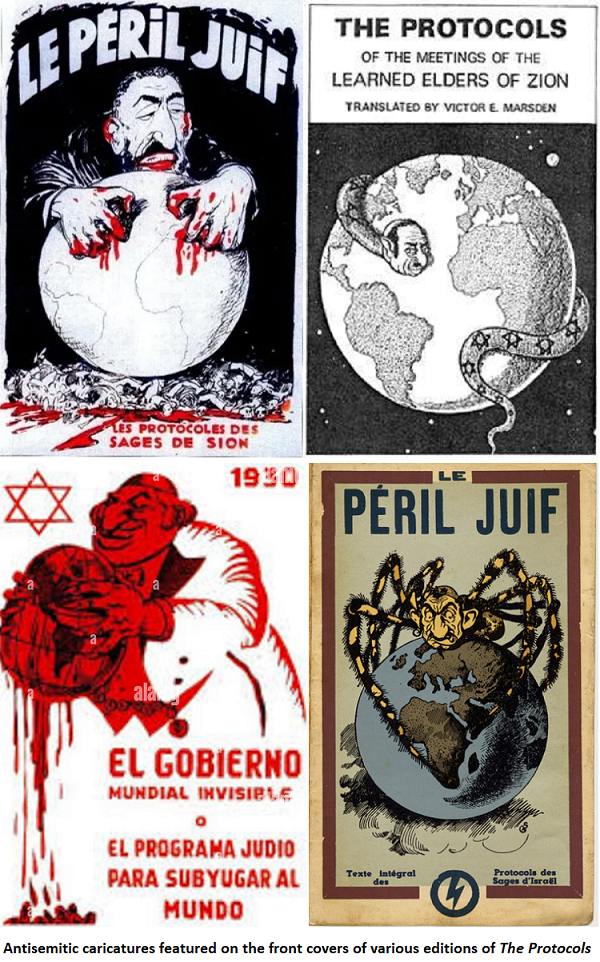
Baddiel also condemned Corbyn for failing to spot what he claimed was another obvious parallel — between the mural and the depictions of “Jewish bankers holding the world to ransom that were published weekly in the Nazi newspaper Der Stürmer”. But Lerman points out that anti-Corbyn commentators who made this comparison (Guardian columnist Matthew d’Ancona had deployed it a week before Baddiel did) were wrong about that too. He writes: “The typical ‘Jew’ in Der Stürmer has an exaggerated hook nose, a bulging, protruding fleshy lower lip, an unshaven rather than always bearded face, eyes suggesting rapacious intent. The figures in the mural, irrespective of what Ockerman has said about them, look like cuddly teddy bears in comparison.” Again, Lerman is right.
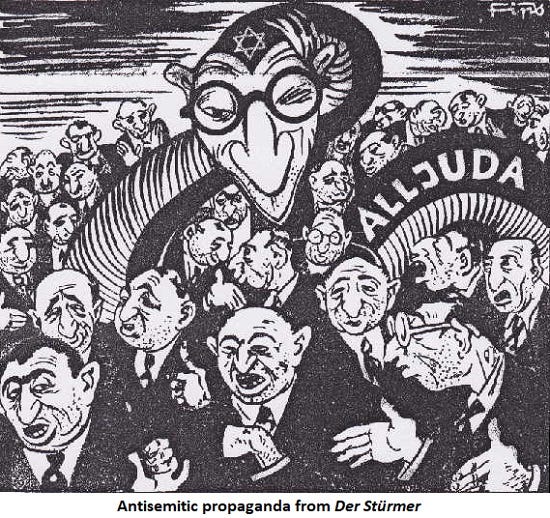
Not that this argument would have any impact on Baddiel, whose ingrained belief in the self-evidently antisemitic character of the mural is impervious to empirical evidence. In his 2022 Channel 4 documentary, also titled Jews Don’t Count, he used a cartoon from Der Stürmer featuring “Jews salivating over an innocent baby they were about to drain the blood off and drink”, as he described it, to illustrate the antisemitic tradition in which Ockerman’s artwork supposedly stood. Baddiel was oblivious to the gulf that visibly separated the imagery in the Nazi cartoon from that in the mural.
On the same day that Berger tweeted her attack on him, Corbyn issued a statement apologising for his response to the mural in 2012: “I sincerely regret that I did not look more closely at the image I was commenting on, the contents of which are deeply disturbing and anti-Semitic. I am opposed to the production of anti-Semitic material of any kind, and the defence of free speech cannot be used as a justification for the promotion of anti-Semitism in any form.”
It did him no good. On 26 March the Board of Deputies and Jewish Leadership Council published an “open letter” to the Parliamentary Labour Party, consisting of a furious rant in which they declared that Corbyn “cannot seriously contemplate anti-Semitism, because he is so ideologically fixed within a far left worldview that is instinctively hostile to mainstream Jewish communities. When Jews complain about an obviously anti-Semitic mural in Tower Hamlets, Corbyn of course supports the artist.”
To reinforce the impact of this attack, the BoD and JLC organised an angry protest in Parliament Square to coincide with the delivery of their “open letter” to the PLP, under the slogan “Enough is Enough”. By the purest coincidence (who could possibly think that politically neutral communal bodies like the BoD and JLC were intent on damaging the Labour Party’s electoral prospects?) this just happened to be the same slogan under which Corbyn had launched Labour’s local election campaign a few days earlier.
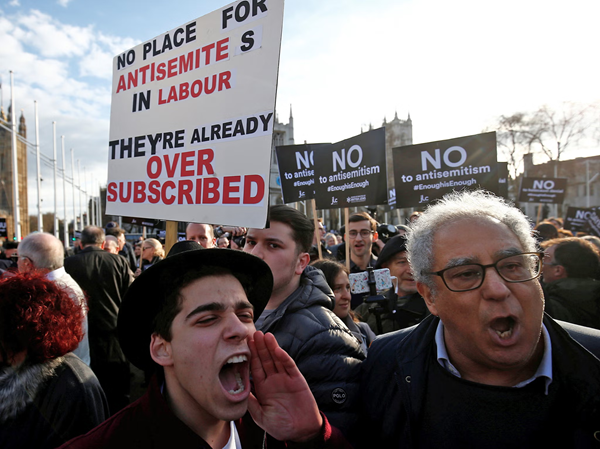
In his reply to the BoD and JLC, also dated 26 March, Corbyn endorsed what was by then the prevailing belief that the mural depicted a group of wealthy Jews oppressing the masses: “The idea of Jewish bankers and capitalists exploiting the workers of the world is an old anti-Semitic conspiracy theory. This was long ago, and rightly, described as ‘the socialism of fools’. I am sorry for not having studied the content of the mural more closely before wrongly questioning its removal in 2012.”

Even at that point, though, it was possible to grasp that the figures in the mural did not in fact consist of “Jewish bankers and capitalists”, and that the assumption on which Corbyn condemned the work as “deeply disturbing and anti-Semitic” was therefore mistaken. On the same day that Corbyn sent his reply to the BoD and JLC, Martin Odoni posted an article on his blog The Great Critique where he challenged this assumption, drawing on the artist’s own previous statements (see here and here) about the individuals he had depicted.
“The rich men portrayed in the mural sitting around the Monopoly gameboard,” Odoni wrote, “include the Rothschilds, the Rockefellers, the Warburgs and the Morgans. The Rothschilds and the Warburgs are indeed Jews. But the others are not. They are portrayed in exactly the same light as the Warburgs and the Rothschilds, but this is not because of their ethnicity, but because they are all banking magnates.” He concluded: “Their portrayal is not anti-Semitic, it is anti-plutocratic.”
Here it is worth pausing to consider the claim that Jews unanimously saw the figures in the mural as antisemitic caricatures, which has become received wisdom among Corbyn’s opponents. Baddiel in particular is a convinced advocate of this view. But it is untenable. David Toube, whose initial scepticism about the antisemitic character of the mural has been cited, is Jewish — so obviously Jewish, in his own mind, that he has announced he may never visit Brick Lane again for fear of a racist attack. (Gotta watch out for those scary Muslims, eh David?) Martin Odoni, whose emphatic defence of the mural I’ve just quoted, is also Jewish.
As indeed is Geoffrey Alderman, who in January 2020 was sacked from his longstanding role as a columnist for the Jewish Chronicle in a decision possibly not unconnected to his stubborn refusal to toe the Zionist establishment’s Corbyn-is-an-antisemite line. In the case of the mural, Alderman referenced Odoni’s analysis in support of his own view that it was not antisemitic, just “a very stark anti-capitalist statement”, and that Corbyn’s apology had therefore been unnecessary.
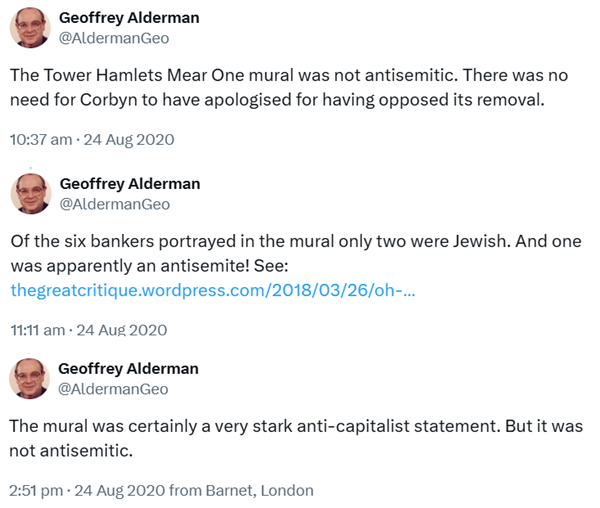
But I digress. To resume our narrative of the 2018 events, on 27 March the mural’s creator further clarified the imagery he had used, when he published a defence of his work on the website of notorious conspiracy theorist David Icke. For the first time Ockerman named all the individuals sitting around the table. The full list comprised an unspecified member of the Rothschild family (probably Walter, of Balfour Declaration fame), plus John D. Rockefeller, J.P. Morgan, Andrew Carnegie, Aleister Crowley and Paul Warburg. So it turned out that four of the six figures were not actually Jewish at all. In fact three of them weren’t even bankers (John D. Rockefeller was an oil magnate, Andrew Carnegie was a steel manufacturer, and Aleister Crowley was an occultist.)
This came as a surprise to those of us who had overlooked Ockerman’s previous statements about the identity of the figures in the mural and had gone along with the view that he’d depicted a cabal of Jewish financiers. Not that it gave pause to Corbyn’s enemies, though. For them it was an unshakeable dogma that the mural was antisemitic, so when it was revealed that only two of the figures were Jews they either ignored this or cynically adapted their arguments accordingly.
Take Dave Rich of the Community Security Trust. Writing for the Jewish Chronicle on 28 March (“Not sure why that mural is antisemitic? Let me explain…”) he insisted that the mural “combines a variety of antisemitic slurs”, although he omitted to inform his readers what these slurs actually were. As for Ockerman’s disclosure that most of the individuals depicted were not Jews, this is how Rich dealt with it: “The mural featured six men: some Jewish and some not. How did the artist differentiate between them? He gave the Jews big noses and other exaggerated facial features.”
The reality is that all the caricatures in the mural were given exaggerated facial features, which is of course one of the defining characteristics of a caricature. Rothschild was portrayed with a large nose, it’s true, but so was J.P. Morgan, even though he was not Jewish. On the basis of their facial features it is difficult to distinguish the Jewish figures in the mural from some of the non-Jewish figures.
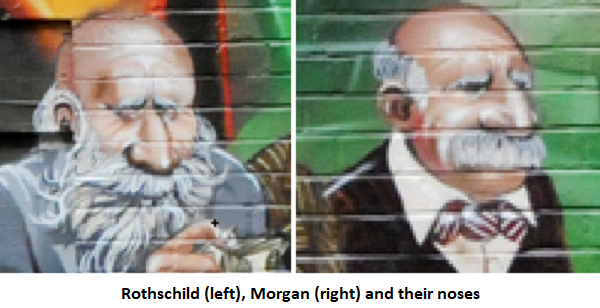
Or take the Labour Party’s training programme on antisemitism awareness. This is delivered by the misnamed Jewish Labour Movement, a hardcore Zionist sect that had been semi-moribund before it was resurrected in 2015 in order to exploit its status as a Labour affiliate and conduct a political war against Corbyn. The Jewish Chronicle reported three years ago that “the notorious mural defended by Jeremy Corbyn” with its portrayal of “hook-nosed bankers playing Monopoly on the backs of the oppressed” is “at the heart” of the programme. “Whereas Corbyn defended this image,” a Labour source told the JC, “course facilitators are using it as a potent illustration of antisemitism.”
The training programme, to which we have access thanks to Heather Mendick, claims that the men playing Monopoly are “a rich Jewish elite” who are “controlling and profiting from the ordinary working classes”. We are told: “Bankers are portrayed with exaggerated noses which is a common antisemitic stereotype. Here they are representing the bankers Rothschild, Morgan and Rockefeller.”
This is of course complete gibberish. As JLM must know very well, the individuals in the mural do not constitute “a rich Jewish elite”. Neither J.P. Morgan nor John D. Rockefeller was Jewish — so, irrespective of the size of their noses, their depictions could hardly amount to antisemitic stereotypes. Rockefeller (second from the left in the mural) is not portrayed with a large nose anyway, and doesn’t look remotely like an antisemitic stereotype. To cap it all he wasn’t a banker — as already noted he was an oil magnate, the founder of Standard Oil. In fact Rockefeller had problems with bankers, who were reluctant to provide loans because they regarded him as a maverick and saw oil exploration as a risky investment.

It is clear that JLM amateurishly cobbled together a story about the antisemitism of the mural without subjecting the work to any serious analysis. They were obviously far more interested in smearing Corbyn as a promoter of antisemitic tropes than in providing an effective education in antisemitism awareness to Labour Party members. All the same, you might have expected JLM to put some minimal effort into constructing a coherent argument to justify their contention that the mural was antisemitic. The fact that they didn’t bother, and took it for granted that they could get away with this stupid nonsense unchallenged, speaks volumes about the way the Labour Party under Starmer has caved in to the Zionist lobby, who evidently feel they are immune to criticism.
As previously mentioned, until I read Ockerman’s 2018 article on Icke’s website I’d accepted the view that the men around the table were rich Jews. After that assumption was demolished by the revelation that four of the six figures were not in fact Jewish, I had to revise my assessment of the work. The first question I thought to ask was why Ockerman should have chosen these particular individuals for his mural. After all, if you were looking for a cast of characters to symbolise global capitalist oppression, these aren’t exactly the first names that would come to mind. Where did he get them from? Given that Ockerman had chosen David Icke’s site as a platform to defend his creation, and that the mural’s imagery clearly indicated a conspiracist worldview, Icke’s theories were an obvious place to look.

As I quickly discovered, Ockerman is a big admirer of David Icke. In a Facebook post and tweet from 2016 he shared an Icke video on the subject of “Rothschild Zionism” and urged his followers to “give one of my heroes a listen”. In support of the video Ockerman wrote: “Back in 2012 I painted a controversial mural a stones throw from London’s financial globalist district and it depicted a group of Banksters playing a game of monopoly on the backs of the working class and the poor. I was labeled Anti Semitic by the Zionist and unconscious supporters of capitalism. David Icke has been plowing through the rhetoric for decades and he happens to be one of a select few who are willing to take a stand against the crimes of humanity committed by the Zionist elite governing the state of Israel and the U.S.” The post concluded with the hashtag #FreedomForHumanity, which is the title Ockerman gave to the mural.
“Rothschild Zionism” is Icke’s name for his deranged antisemitic conspiracy theory that the world is secretly controlled by the Rothschild family. Cunningly, these evil Jewish bankers conceal their power by hiding behind various businessmen and politicians who over the years have served as the Rothschilds’ accomplices. Paul Warburg is described in The David Icke Guide to the Global Conspiracy as a “Rothschild agent” who created the Federal Reserve on the Rothschilds’ behalf, so that they could control the US financial system. Although Warburg was himself Jewish, many other agents of “Rothschild Zionism” are not. Icke often refers to the Rockefellers, Morgan and Carnegie as examples of non-Jewish capitalists who have acted as front men for the Rothschilds. Here is an excerpt fron Icke’s book Human Race Get Off Your Knees in which this is spelled out very clearly:
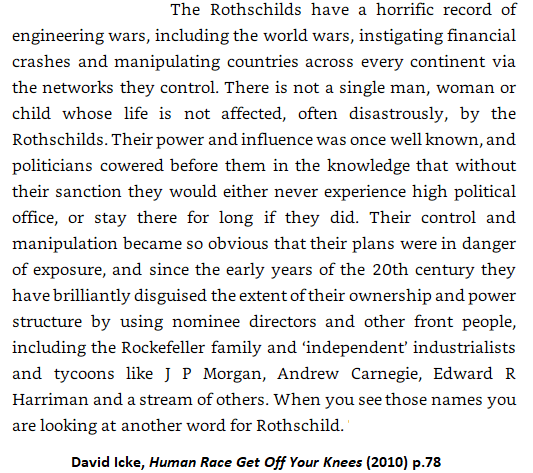
So much for the argument that the mural couldn’t be antisemitic because John D. Rockefeller, J.P. Morgan and Andrew Carnegie were not Jewish. This is not to say that the mural is reducible to the theory of Rothschild Zionism. though. Five of the six individuals in the mural (Rothschild, Warburg, Rockefeller, Morgan and Carnegie) feature in that conspiracy theory, but Aleister Crowley does not (although he does figure elsewhere in Icke’s writings). Also there is other stuff going on in the mural.
The New World Order fantasy, according to which a secret global elite is plotting to impose an authoritarian world government, is incorporated into the design, with a protester wielding a placard reading “The New World Order is the enemy of humanity”. Not all versions of the NWO conspiracy theory attribute a dominant role within the global elite to Jews. However, in view of Ockerman’s enthusiastic approval of Icke’s deluded belief in the controlling power of the Rothschild family (the Rothschilds feature even more prominently in a 2016 revised print version of the mural) it is difficult to see how his conception of the NWO can be anything other than antisemitic.

It’s also worth noting that the Eye of Providence, which holds significance for conspiracy theorists because of its link to Freemasonry, occupies a central position in the mural. Ockerman stated that here he took “visual inspiration from the U.S. Dollar bill, which holds sacred Freemason iconography, such as the ‘all seeing eye’, accompanied by cryptic Latin inscriptions like ‘novus ordo seclorum’ or ‘new order of the ages’.” He added that the dollar’s design includes “several other hidden symbols, which some may argue have Jewish influences, such as the star configuration that rises above the eagle crest forming a two-dimensional tetrahedron, considered by some as the star of David, I always wondered why?”
As I pointed out in an earlier article, this association of Jews and Freemasons, in the context of an imaginary plot to establish a New World Order, carries disturbing echoes of the Judeo-Masonic conspiracy theory that originated in The Protocols.
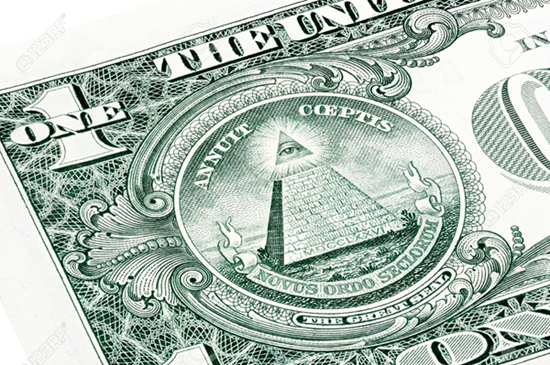
In light of all this, it is impossible to sustain the argument that the mural was not at all antisemitic, merely anti-capitalist. However, nobody could reasonably be accused of softness on antisemitism because they failed to understand the ideological underpinnings of Ockerman’s artwork on their first sight of the mural in 2012. That understanding required an investigation into the conspiracy theories that inspired the work — it couldn’t be established directly from visual evidence. Corbyn’s too-ready acceptance of the false claim that the antisemitism of the mural was immediately identifiable from its imagery, and that he was at fault for not recognising this, just provided ammunition for his opponents. Before he is subjected to further attacks on this issue, as he inevitably will be, he would be advised to develop a more robust response.
First published on Medium in August 2025